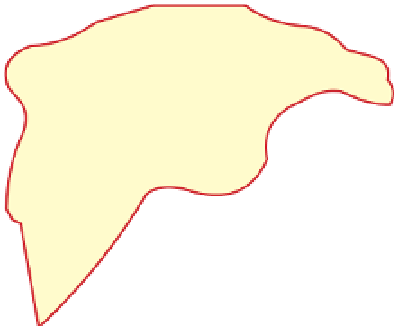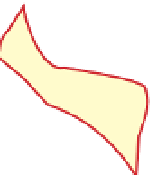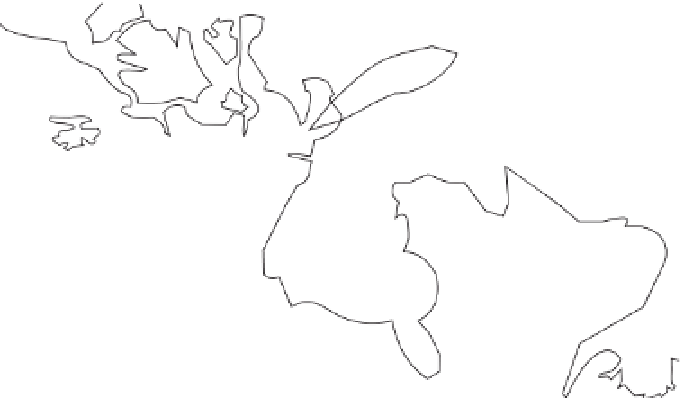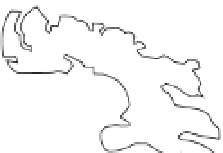Geology Reference
In-Depth Information
Figure 12.9
The Trans-Hudson orogen. Simplified sketch map
of northern North America showing the various components of
Laurentia. The various cratons and terranes making up the upper
plate of the main Hudsonian collision orogen are shown in yellow;
the lower plate, the Superior craton, is shown in pale orange.
Important areas of oceanic volcanics and granitic plutons are also
shown.
500km
Rae
VI
Foxe
CB
Great
Bear
Lake
THO margins
?
MI
NAC
, North Atlantic craton;
CZ
, Core Zone terrane;
MI
,
Rae
Slave
Meta Incognita terrane;
CB
, Cumberland batholith;
WB
, Wathaman
NAC
batholith;
SK
, Sask terrane;
CS
, Cape Smith belt;
VI
, Victoria
CZ
pre-
Hudson
orogen
Island;
, Torngat Belt; the outline of Greenland
has been omitted for clarity. Based on Corrigan
NS
, Nova Scotia;
TB
et al.
(2009).
?
WB
Hudson
Bay
Taltson-
Thelon
convergence can often be deduced by
structural evidence from thrusts, etc.
Hearne
SK
Structure of the Trans-Hudson orogen
(THO)
The western part of the THO (Figure
12.9) is known as the
Western Churchill
Province
and consists of the
Hearne
craton
and the
Sugluq craton
, together
with the eastern Rae craton and the
zones of collision between them. In
the north, the collision was between
the Rae and
Meta Incognita
cratons,
resulting in the
Foxe orogenic belt
. This
collisional belt also affects the sedimen-
tary cover of the Rae craton (the
Piling
Group
) consisting of a shallow-marine
shelf sequence overlain by a foredeep
basin - the
Penrhyn-Piling basin
.
The eastern part of the THO is usually
known as the
Reindeer zone
. This zone
contains a series of oceanic volcanic
arcs, back-arc basins and oceanic pla-
teaux (
La Ronge-Lynn Lake
,
Flin-Flon-
Glennie
, and
Parent-Spartan
oceanic
arc terranes) originating in the former
oceanic area between the Hearne and
Sugluq cratons on the western side
and the Superior craton on the eastern
side, and which became accreted
to the Hearne and Sugluq cratons
before the final closure of the ocean.
The north-eastern arm of the THO,
termed the
Eastern Churchill Province
,
Superior
New
Bruns-
wick
THO margin
NS
cratons
volcanic arc
granite pluton
syn-orogenic
basin
upper
plate
lower
plate
Wyoming
Labrador in the east, where it is cut off
by the younger Grenville belt, measures
over 3000 km. Together with the greater
part of Greenland, this Precambrian
continent is known as
Laurentia
.
The Trans-Hudson belt itself varies in
width from about 500 km in the south-
west to over 1300 km in the Hudson Bay
embayment. It is bounded on its north-
west side by the Archaean
Slave
craton
together with that part of the Archaean
Rae craton
unaffected by Hudsonian
overprint. Between these two Archaean
cratons is another Early Proterozoic oro-
genic belt, known as the
Taltson-Thelon
belt
, formed before the Trans-Hudson
orogen. North of the Superior craton, a
branch of the Trans-Hudson belt turns
southeast, bounded by the Archaean
North Atlantic craton
on its northeast
side; here the belt is narrower - about
400 km wide. North of Baffin Island,
the main belt, known here as the
Foxe
belt
, continues into west Greenland.
As is the case with the Grenville
belt described above, this ancient
orogen has completely stabilised,
much of the younger cover has been
removed, and relatively deep-level
rocks are now exposed at the surface.
Consequently, with the aid of a good
coverage of high-quality age dates,
it is possible to determine the posi-
tion of the sutures between pieces
of crust of different age, and thus to
piece together the possible sequence
of events leading up to the final amal-
gamation of the Laurentian continent.
Knowledge of the palaeomagnetic
record of the Archaean components
of the orogen is sparse, and therefore
the relative position of the component
cratons prior to amalgamation is mostly
guesswork, although the directions of






























Search WWH ::

Custom Search